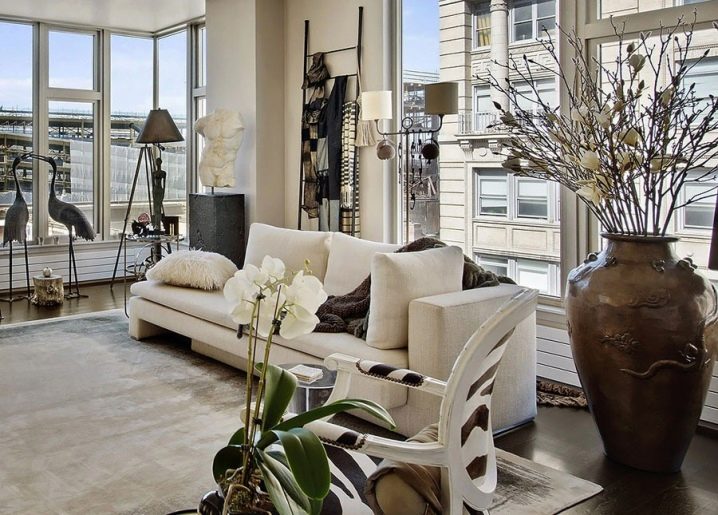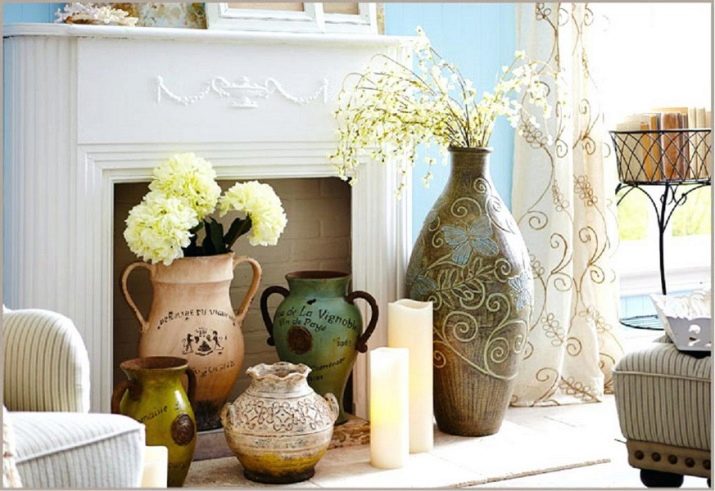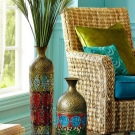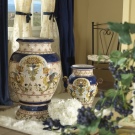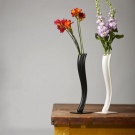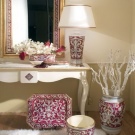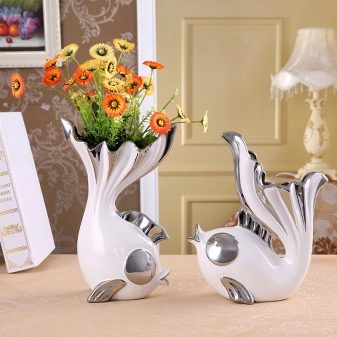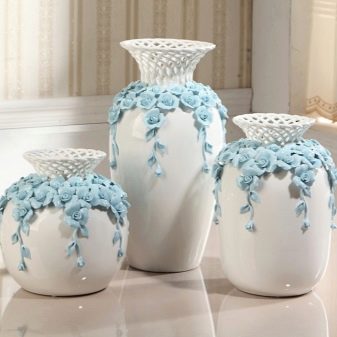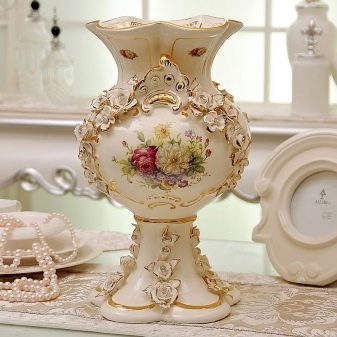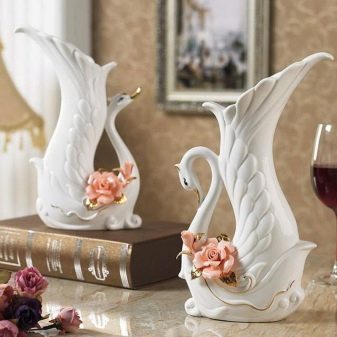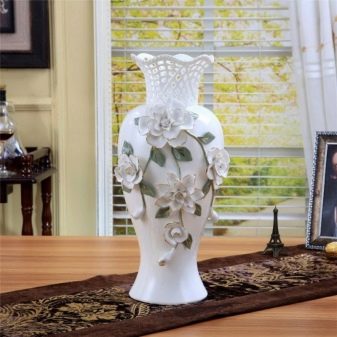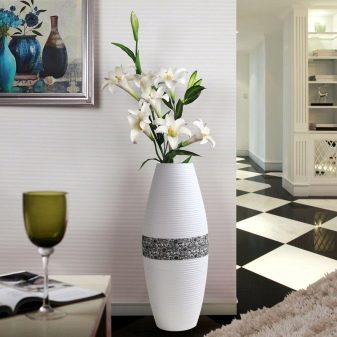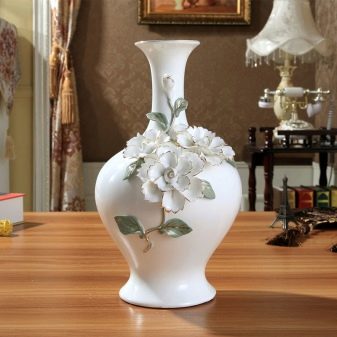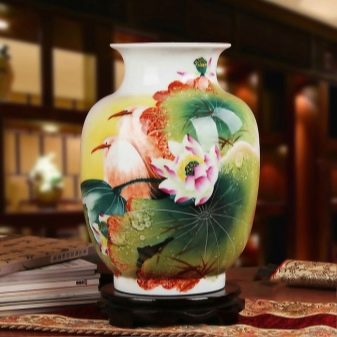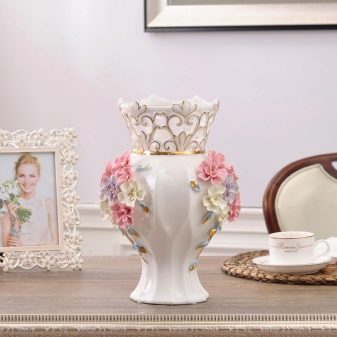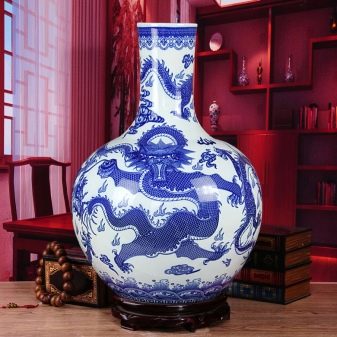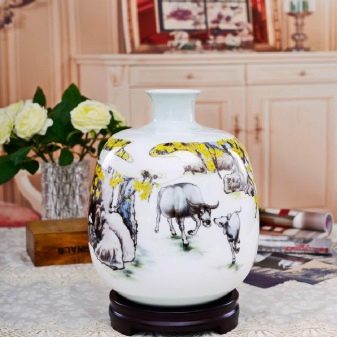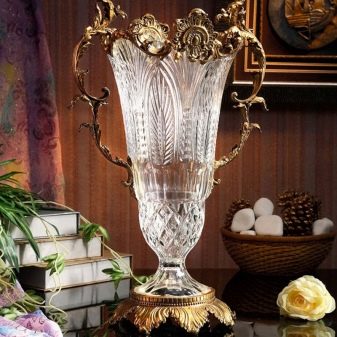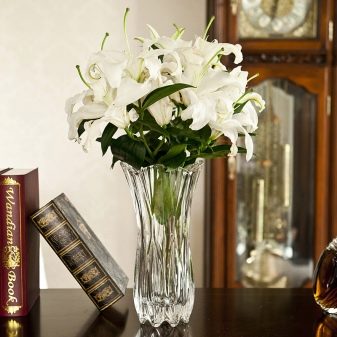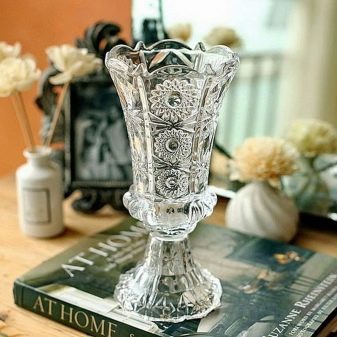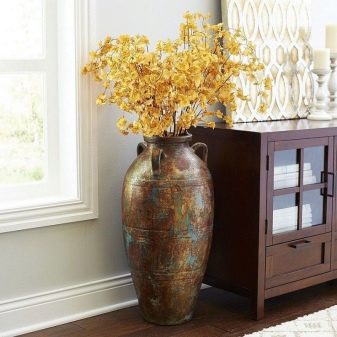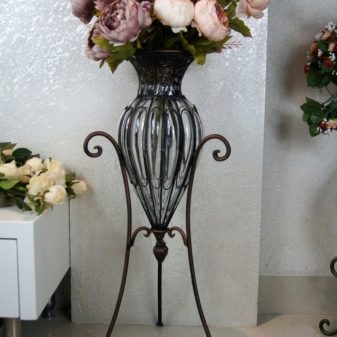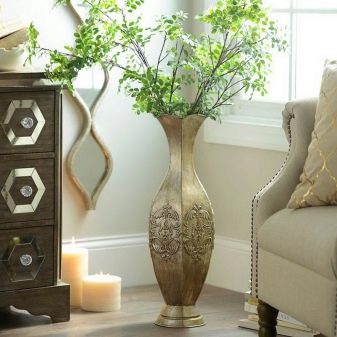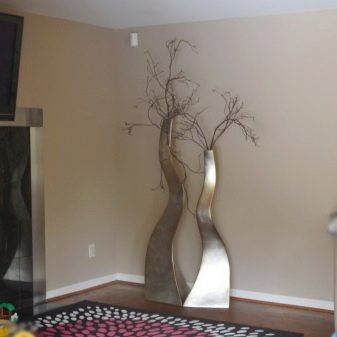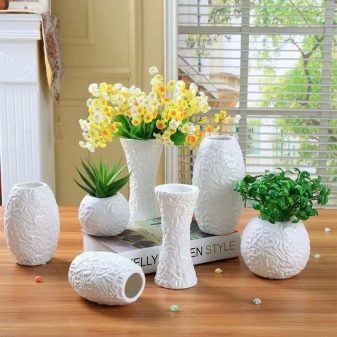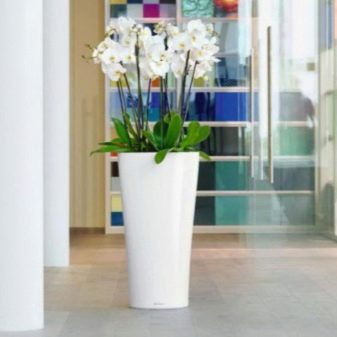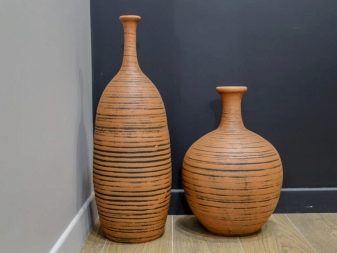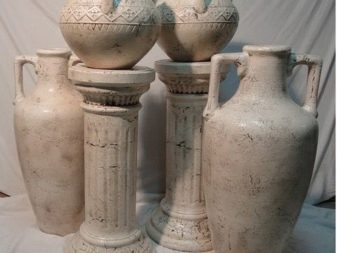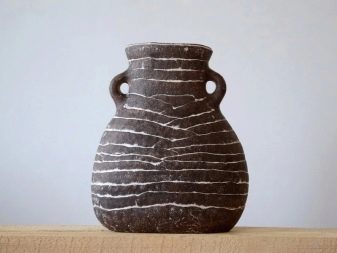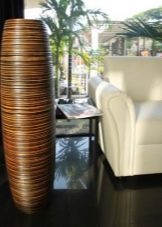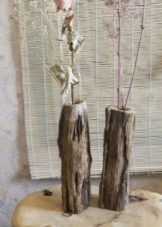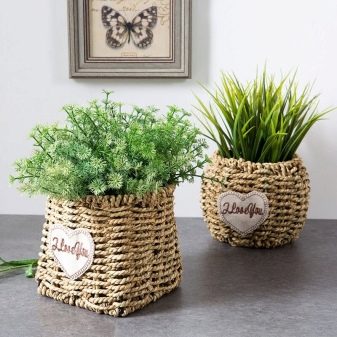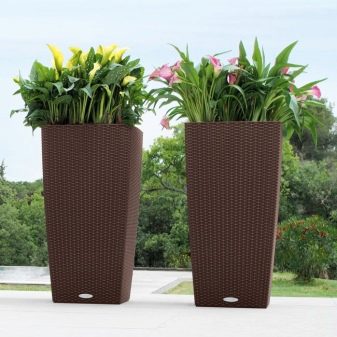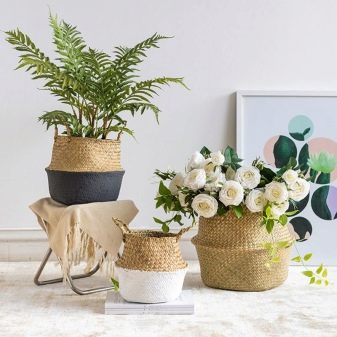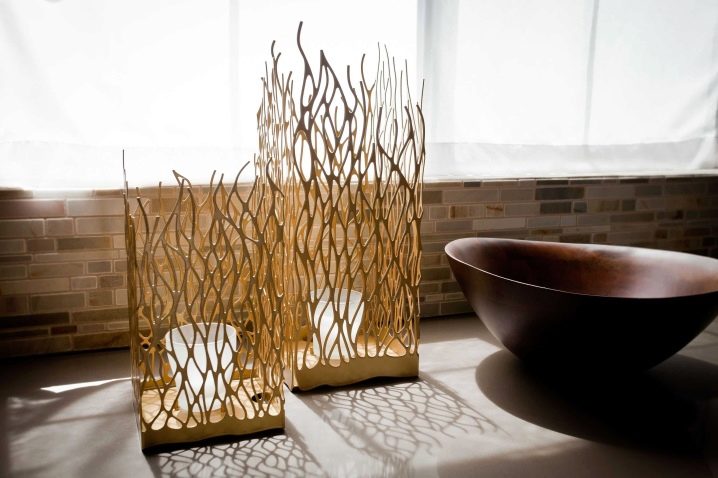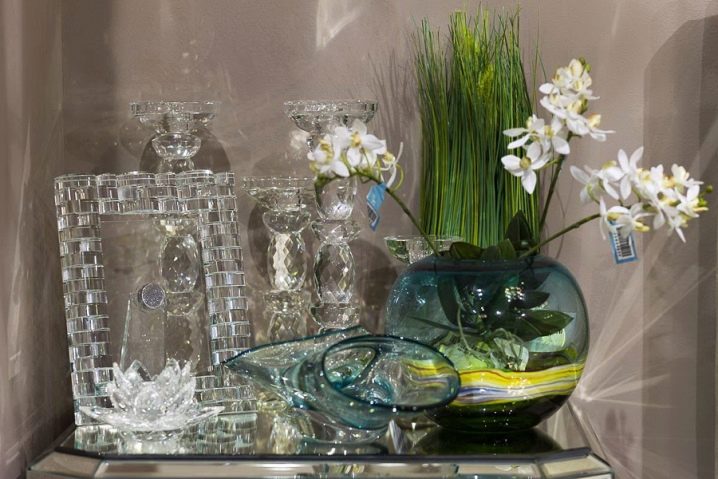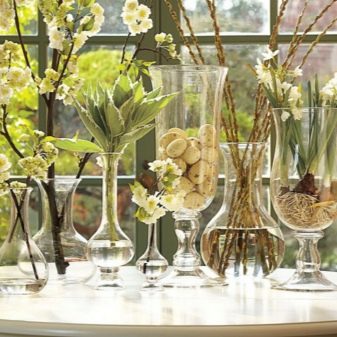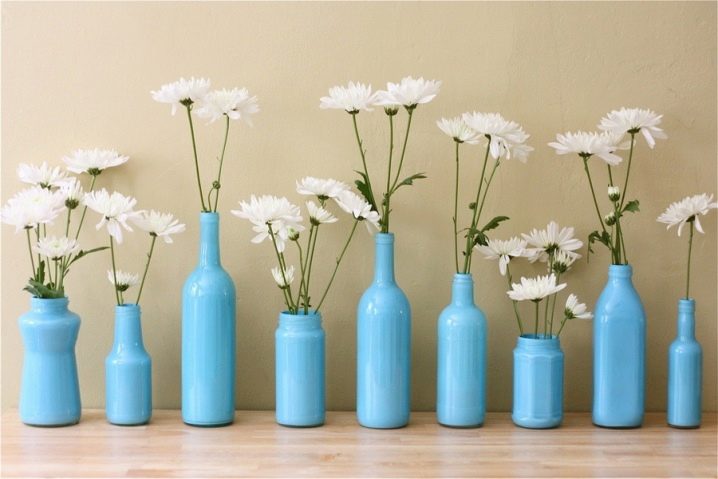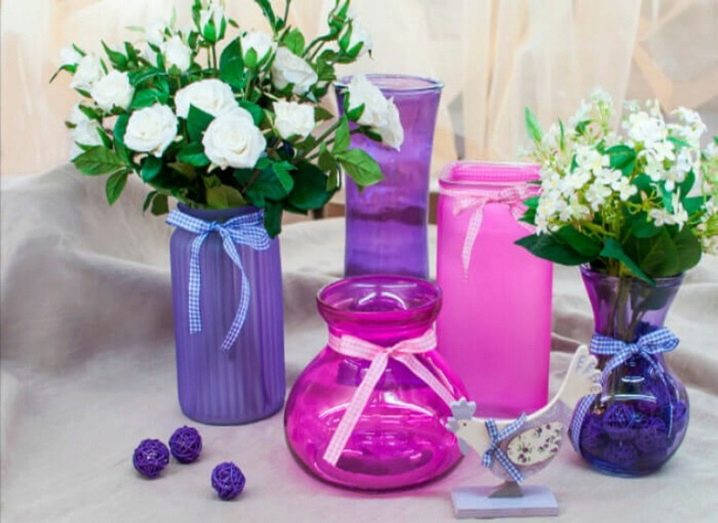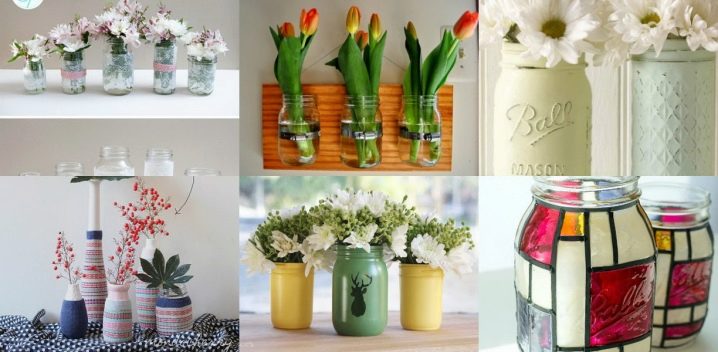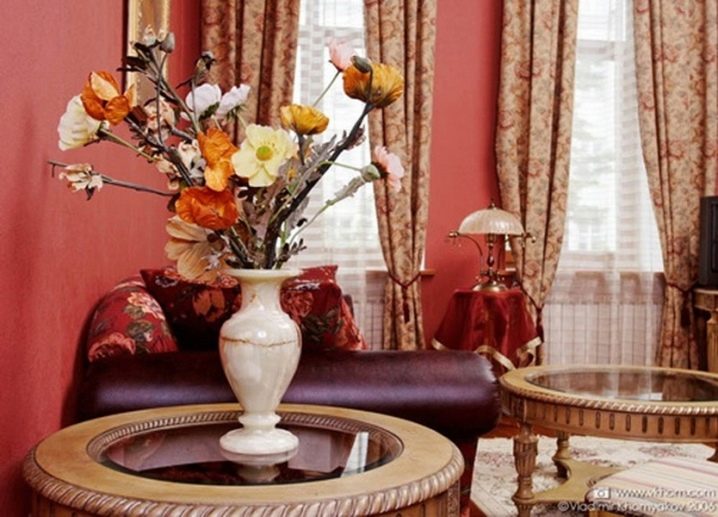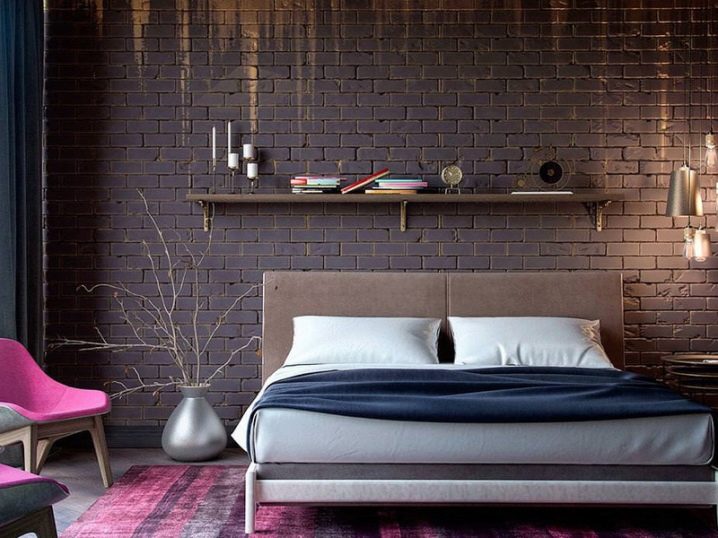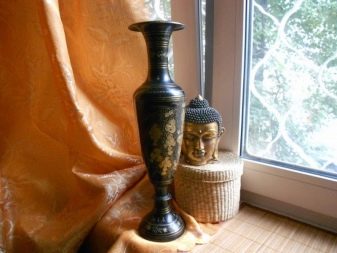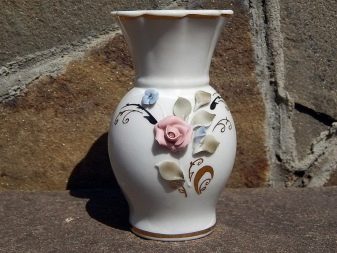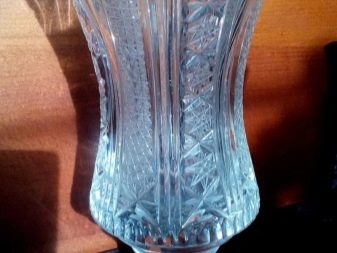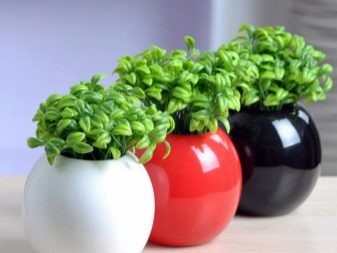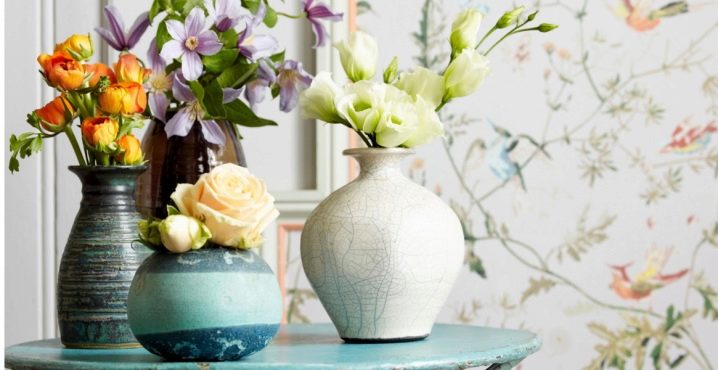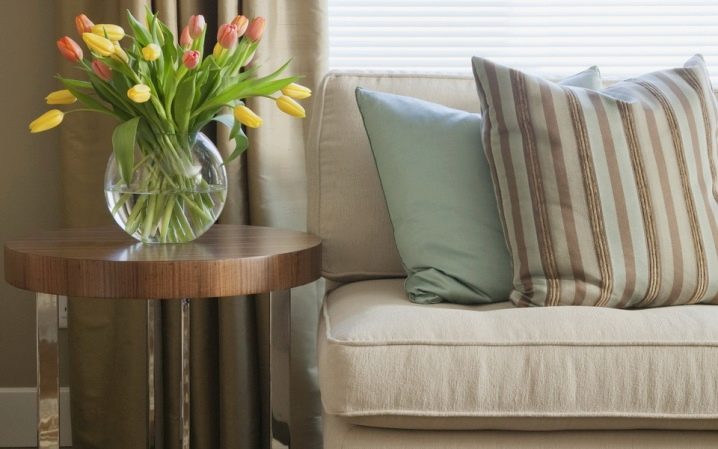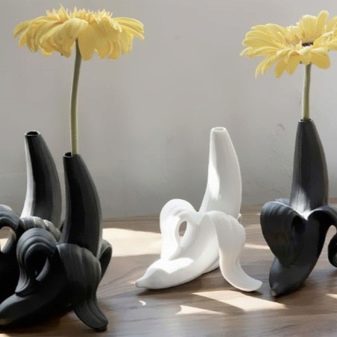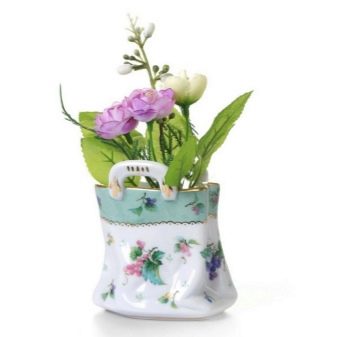Vases: a variety of materials and forms in the interior
Attitude to the vase, as a bourgeois relic of the past, is fundamentally wrong. Irritating the vessel on the shelf, which means you need another, and in the right place. A large floor vase will make an empty corner volumetric. Bright design instances, in combination with another decor, will refresh monochrome interiors. Clay jug with wildflowers on the dining table will add mood and improve the appetite.
Kinds
The primary task of a vase is to serve as a container for flowers, but they are also important for interior decor. Original, elite vessels of different shapes and sizes, with and without legs, will satisfy any design requests. Countless vases can be divided into types:
- floor and table;
- home and street;
- for bouquets and one flower;
- floral and ornamental (which do not hold water);
- by material;
- in form;
- to size.
Material
The material from which the vase is made, not only affects the interior styling. It also determines how long the flowers will remain in the vessel fresh. Ceramic containers made of clay, can "breathe", pass air. This property helps flowers maintain their vitality longer. Metal and plastic act exactly the opposite; plants die very quickly. Such products are good for interior decoration, but not very suitable for living flora.
Ceramic options are fascinating in the outdoor version. Popular painting Gzhel for light airy interiors. Clay is easy to sculpt, takes any form and is well painted. Glass vases are the most common. An abundance of shapes and colors allows you to pick them up for all occasions. They are very good and in the gift version.
Porcelain vases were still loved by our grandmothers and great-grandmothers. They adorn many museums. There are amazing grades of blue clay from which the finest porcelain is made. If you bring such a product to a bright light, you can evaluate its transparency.
Crystal vase tried to get every Soviet family. The presence of lead in the glass makes it ringing and especially transparent. Thick carved walls of the vessel beautifully refract light. It goes well with crystal glasses on the festive table.
Metal products need certain styles, yellow aged metal with beautiful carvings can suit oriental themes. Beautifully look Chinese vases, painted with colored dragons. Silver vessels look expensive, but they need occasional care, as silver darkens. The same applies to bronze, brass, copper. Forged vases will support the gothic interior and chalets. And chrome is necessary for minimalism, techno, hi-tech.
Plastic models are lightweight and durable, are inexpensive and have a large selection. Some types of plastic, especially transparent, quickly lose their original appearance. Such vases are unlikely to be passed from generation to generation.
Fireclay vessels They remind of ancient products, but they are preferred by modern styles, although often such products can be found in classical interiors. Gypsum vases are inexpensive.Those who like to engage in creative work will be able to easily cast plaster into a homemade form, and then paint the finished product. Concrete options are designed to decorate facade areas, courtyards and landscaped areas.
Country Directions (Country, Provence), eco and ethno styles can not do without products from natural gifts. And nature is generous to beautiful, original, environmentally friendly materials. Wooden vases are good in carved design, but the smooth walls of the product with an unusual pattern of natural wood look attractive. Unfortunately, wood is afraid of moisture and dries out at high ambient temperatures.
Flowerpots weave rattan and wicker, they turn out cozy, light, but suit only under dried flowers. Sometimes glass jars are braided with natural material, in such products fresh flowers will stay fresh and look organic.
Bamboo vases are lightweight and durable. They will decorate the interior of the traveler, support the marine and eco style. Vases from a natural stone look richly, royally. Onyx, agate, malachite, topaz have unique colors and patterns, looking at them, you understand that nature is an unsurpassed artist.
Sizes and shapes
Contemplating the flowers, one wonders what nature has not come up with just the sizes and shapes, creating these beautiful, but short-lived masterpieces. Vases should also be to match them: beautiful and diverse. You can not dip a flower in any vessel that came to hand. These beautiful components must unite in a single whole, that is, fit in shape, size and other parameters.
Miniature primroses will decorate small jugs of rounded shapes or vases in the form of glasses. The longer the flower stem, the higher the vase should be. Narrow is suitable for single plants, wide - for a bouquet. Narcissus stems look good in glass products. Field flowers (sainfoin, sweet clover, daisies) need simple, uncomplicated options - jugs, ceramic pots. Gentle meadow bouquets will be uncomfortable in expensive prim vases.
A glass vessel that goes into expansion, like a glass, is well suited for tulips, daffodils, and irises. For flowers with long stems, you should not choose a transparent vase; a porcelain one is more suitable. In a high ceramic container, gladioli, delphiniums and Dutch roses look beautiful.Bright vases from simple glass with meadow bouquets will decorate the interior in Provence and Country style. To please each flower, the forms of vases have a wide variety.
- Cylindrical look great in both ceramic and transparent glass. Suitable for tall plants.
- Round patterns are found in abundance: from large outdoor stone options to miniature beads that adorn elegant glass shelves. In group collections, round vases are well combined with elongated products that match in color or material.
- Square and rectangular containers are necessary for modern urbanistic trends (minimalism, techno, loft).
- The unusual, irregular shape of the vessel is the most attractive. It breaks stereotypes and attracts attention, so there should not be much flowers in such a vase, but just enough to carry out the designer's intention. For example, for a vessel in the form of a torch, a scarlet rose, symbolizing the flame, is suitable. Sometimes a vase of irregular shape is combined with a flower that continues its geometry.
Colors
A vase is a decoration that complements the interior, and its color is important, especially in combination with plants.It can either merge with the decor, or be an accent. Beautiful expensive furniture wins in the absence of bright spots of decor, in such cases, the vases repeat the color of the furniture, but the flowers in them can be bright active colors. Conversely, with an accent vessel of unusual shape and in pronounced color, the plants should be invisible.
Sometimes a model is selected in the color of the walls; it creates volume in empty space, especially for floor options. Contrast vessels in two-tone interiors, such as extravagant black-and-white, are well-beaten up when a black vase is set against a white background and vice versa. The same techniques work with colored interiors. You can use another interesting technique: put two vases of the same size and texture alongside, but one will repeat the color of the furnishings, and the second will be an accent one. Bright products are so good that they can be placed on different levels: on the floor, table and wall shelf.
Each color in its own way affects the situation in the room.
- Black glossy vessel emphasizes special elegance. It requires only bright flowers: purple, scarlet, yellow, orange.
- Silver products will complement the eastern and urban interiors.
- A brown pot wins in the presence of beige walls or furniture.
- Gray tone needs a bright addition, the plants must be flashy, energetically active.
- Blue - this color is not worth overloading the situation, a few modest vases will be enough.
- The green color of the vessel will suit eco style and lovers of green interiors.
Style and design
There are no such styles that would categorically reject vases as decoration. Even ascetic minimalism will adequately respond to the chrome-plated copy of simple, clear forms. Vanguard and loft will order an exclusive in the form of a piece of drainpipe. Pop art will decorate the shelves with containers made of Pepsi-Cola brand cans. For each apartment there is its own special vase. Classic interiors prefer traditional materials - glass, porcelain, crystal with soft sleek shapes.
Modern styles (hi-tech, minimalism) are characterized by transparent and reflective textures, they are suitable for glass and metal products. They play with light, attract glitter, but at the same time they look simple, without excesses.If there is a need for color, the vase is selected according to the setting, but kept in one key. In the interior of the loft, you can enter a vase made of plaster, concrete, chrome-plated metal.
For ethnic styles are characterized by vessels made of natural materials with folk ornaments of thematic countries. On vases there can be images of a Greek meander, totem animals, hieroglyphs. Chinese interior will be decorated with porcelain vases depicting mythical animals, as well as bamboo products. Mosaic vessels that embody the flavor of Arabian fairy tales will support the Eastern theme. Vases made of chamotte clay are suitable for the Greek style.
Famous manufacturers and reviews
Vases of any kind can be ordered in Ikea stores, transparent glass products from their collections are surprised by the variety of geometric shapes. Judging by the reviews, companies have proven themselves well:
- “Composite Era” - offers plastic and glass vases;
- "Profservice - Czech Crystal" - you can buy crystal products from the Czech Republic;
- India-shop - models from India;
- "Kislovodsk Porcelain - Phoenix" - handmade porcelain vases.
How to choose?
How to choose a vase so that it is beautiful and modern? First, the goal is determined, for which it is needed. If we are looking for a pair of a rounded red lamp, then the vase should also be red and round. You can fill the void with a large floor vessel. Create a mood will motley group of glass products. To support the mirror theme in the interior will help chrome copies.
For large living rooms fit bulk vases, material and color is selected taking into account the situation. In the smaller hall we need vessels commensurate with the space.
In the kitchen, meadow flowers are always appropriate, and therefore vases made of natural material, with the exception of cold minimalist dining rooms, where high flasks of tempered glass can play the role of a vase. The bedroom is characterized by vases-lamps or warm calm vessels for flowers in pastel colors. Shades can coincide with pillows and other types of decor.
An empty corner in the hallway will be occupied by a narrow long vase.
Vessels for children's rooms choose bright, from unbreakable materials. Children can store pencils in them or use them for small objects. For the bathroom are selected models of ceramics and chrome.Dried flowers are used as a filler.
Successful examples and options
Vases are intended both for live bouquets, and for compositions from artificial plants. But they are completely self-sufficient to do without filling. A beautiful example of a sculpted vase. Handicraft in ethnic style (Africa). Vase- "banana" for one flower.
The plot option - "Handbag", hand-painted. Glass vase "Garden". In conclusion, it can be said that vases are a completely worthless item. They smooth corners, set accents. They need to have different shapes and sizes to match any bouquets given.
For information on how to choose a glass vase, see the next video.

